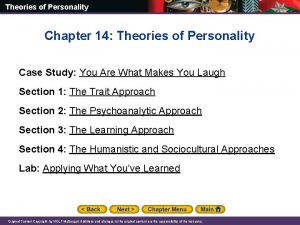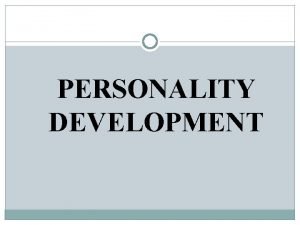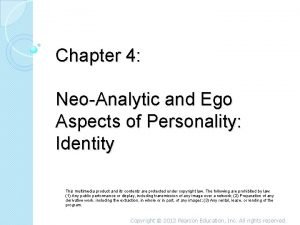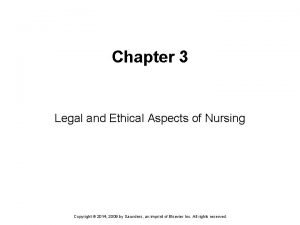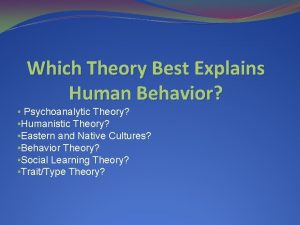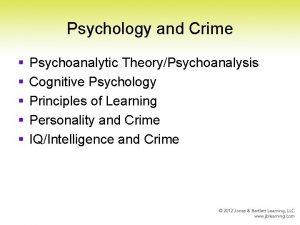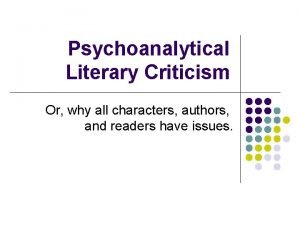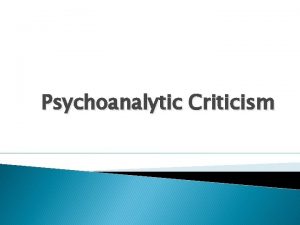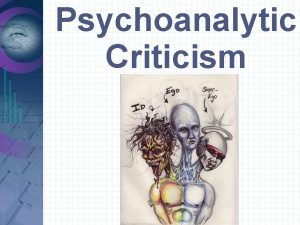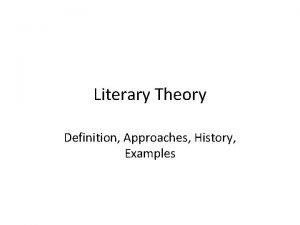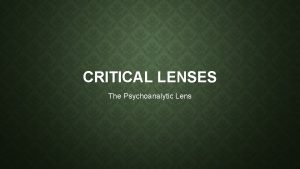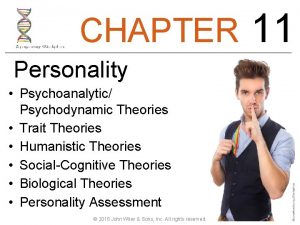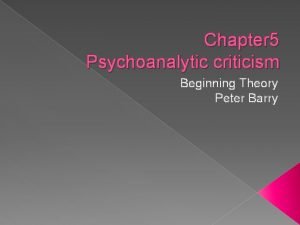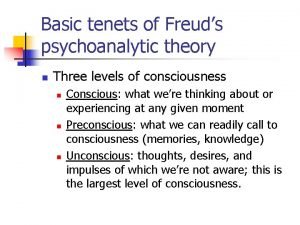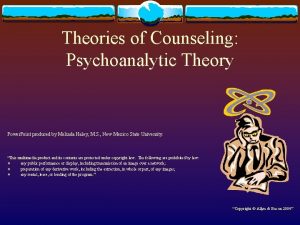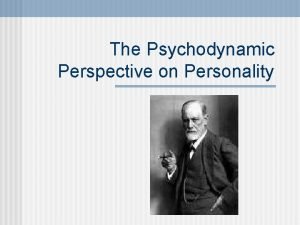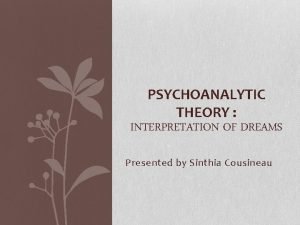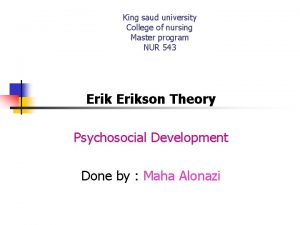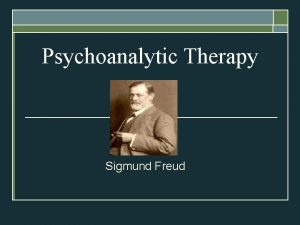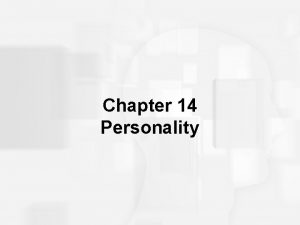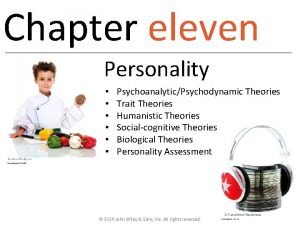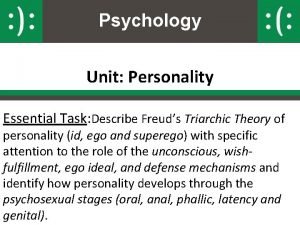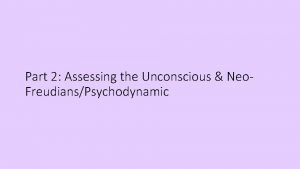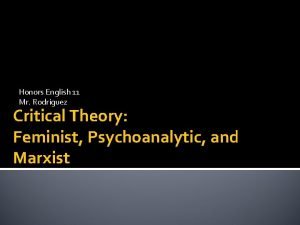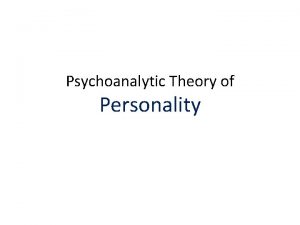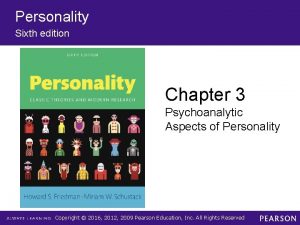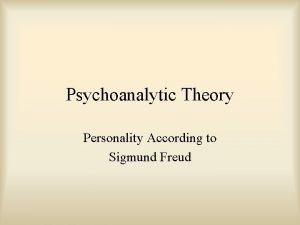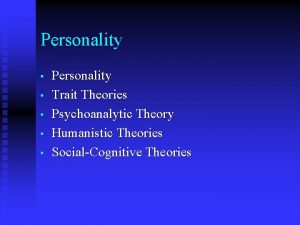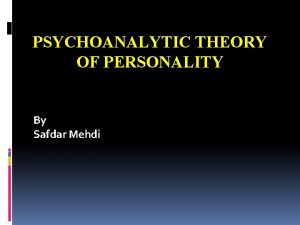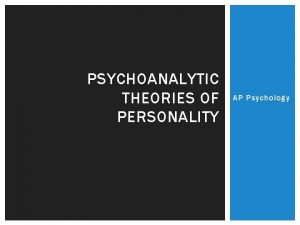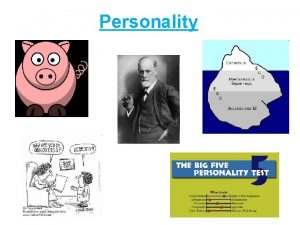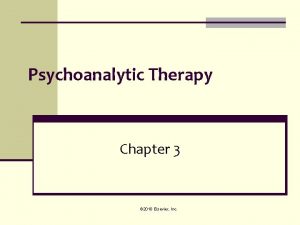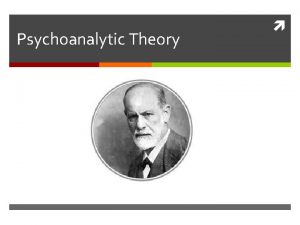Chapter 3 Psychoanalytic Aspects of Personality This multimedia





































- Slides: 37

Chapter 3: Psychoanalytic Aspects of Personality This multimedia product and its contents are protected under copyright law. The following are prohibited by law: (1) Any public performance or display, including transmission of any image over a network; (2) Preparation of any derivative work, including the extraction, in whole or in part, of any images; (3) Any rental, lease, or lending of the program. Copyright © 2012 Pearson Education, Inc. All rights reserved.

Psychoanalytic Approach Personality theory based on the writings of Sigmund Freud Emphasizes the unconscious processes of the mind Copyright © 2012 Pearson Education, Inc. All rights reserved.

The Unconscious The portion of the mind of which a person is not aware Psychoanalytic techniques to access the unconscious ◦ Hypnosis ◦ Free Association ◦ Dream Analysis Copyright © 2012 Pearson Education, Inc. All rights reserved.

Dreams The “royal road” to the unconscious Manifest content ◦ the content of a dream that a person remembers Latent content ◦ the underlying hidden meaning of a dream Copyright © 2012 Pearson Education, Inc. All rights reserved.

Parts of the Mind Copyright © 2012 Pearson Education, Inc. All rights reserved.

Parts of the Mind Copyright © 2012 Pearson Education, Inc. All rights reserved.

Psychosexual Development � The development of the psyche � Progresses in stages as the libido (desire, sexual energy) is redirected to different parts of the body � Psychosexual Stages ◦ ◦ ◦ Oral Anal Phallic Latency Genital Copyright © 2012 Pearson Education, Inc. All rights reserved.

Oral Stage Theme ◦ Infants are driven to satisfy the drives of hunger and thirst Conflict ◦ Child must give up breast feeding Fixation ◦ Dependency ◦ Preoccupation with oral acquisition Copyright © 2012 Pearson Education, Inc. All rights reserved.

Anal Stage �Theme: ◦ Child receives pleasure from relieving self of bodily waste �Conflict: ◦ Child is “toilet trained” �Fixation: ◦ Preoccupation with neatness ◦ Excessive “bathroom humor” ◦ “anal-retentive” and “anal-expulsive” characteristics Copyright © 2012 Pearson Education, Inc. All rights reserved.

Phallic Stage Theme: ◦ Child gains pleasure through the genitals ◦ Oedipus Complex-Boys desire mother Castration anxiety ◦ Electra Complex-Girls suffer penis envy Conflict: ◦ Overt sexual behavior socially unacceptable Fixation: ◦ Vanity, narcissism, inability to love Copyright © 2012 Pearson Education, Inc. All rights reserved.

Latency Stage Theme: ◦ Psychosexual energy is channeled into academic and social pursuits Conflicts and fixations do not occur during this stage Copyright © 2012 Pearson Education, Inc. All rights reserved.

Genital Stage Theme: ◦ The individual gains satisfaction from mature sexual relationships This stage is achieved if a person makes it through the other stages with enough available sexual energy ◦ no strong fixations ◦ “normal” (conventional) adult sexuality is viewed as the healthy outcome Copyright © 2012 Pearson Education, Inc. All rights reserved.

Defense Mechanisms The ego must balance the demands of the id, the super-ego, and reality Defense Mechanisms ◦ Ego processes that distort reality to protect the individual from anxiety ◦ Prevent threatening unconscious material from reaching consciousness Copyright © 2012 Pearson Education, Inc. All rights reserved.

Defense Mechanisms Repression Pushes threatening thoughts and ideas into the unconscious As an explanation for: ◦ Post-traumatic stress disorder ◦ Repressed memories ◦ False memories Copyright © 2012 Pearson Education, Inc. All rights reserved.

Defense Mechanisms �Reaction formation �Hides threatening impulses by overemphasizing their opposite �As an explanation for: ◦ Rabidly homophobic people turning out to be closeted gays ◦ Inappropriate sexual escapades by politicians and clergymen who promote “family values” Copyright © 2012 Pearson Education, Inc. All rights reserved.

Defense Mechanisms Denial Refusal to acknowledge anxietyprovoking stimuli As an explanation for: ◦ Not acknowledging the sudden death of a loved one ◦ Interpreting a terrible fight with a spouse as just a “lovers quarrel” Copyright © 2012 Pearson Education, Inc. All rights reserved.

Defense Mechanisms Projection Attributing anxiety-provoking impulse or thoughts to others As an explanation for: ◦ Always being suspicious of others ◦ Extreme political opinions Copyright © 2012 Pearson Education, Inc. All rights reserved.

Defense Mechanisms �Displacement �Shifting one’s unconscious aggression or fears to a safer target (hydraulic model) �As an explanation for: ◦ The case of Little Hans ◦ “Kicking the dog” Copyright © 2012 Pearson Education, Inc. All rights reserved.

Defense Mechanisms �Sublimation �Dangerous urges are transformed into positive, socially meaningful motivations �As an explanation for: ◦ Artistic creativity ◦ Community leadership Copyright © 2012 Pearson Education, Inc. All rights reserved.

Defense Mechanisms Regression Protecting the individual by returning to an earlier, “safer” time of life As an explanation for: ◦ A child with a new baby sibling wanting a bottle again ◦ When an adult whimpers ◦ A distressed individual treating his/her spouse as a parent Copyright © 2012 Pearson Education, Inc. All rights reserved.

Defense Mechanisms Rationalization Creating logical, socially acceptable explanations for behaviors which were actually driven by unconscious impulses As an explanation for: ◦ Lying and then claiming the lie was to protect the feelings of another person Copyright © 2012 Pearson Education, Inc. All rights reserved.

Current Applications: Unconscious Emotions Freudian theory speculates that we can experience internal arousal that we do not cognitively understand Neurological research shows that some emotional events can exist independent of thought Copyright © 2012 Pearson Education, Inc. All rights reserved.

Current Applications: Hypermnesia “Excess memory” The link between the psychoanalytic tool of free association and the more modern notions of signal detection theory ◦ Rewards for producing good material ◦ No penalty for “false alarms” Copyright © 2012 Pearson Education, Inc. All rights reserved.

Current Applications: Infantile Amnesia Freud noted that adults cannot remember much from their early years ◦ He attributed this to traumatic conflicts in early life Research has found that all early memories are forgotten, not just traumatic ones Copyright © 2012 Pearson Education, Inc. All rights reserved.

Current Applications: Memory is imperfect and subjective ◦ memories change over time ◦ all memories vary in their “availability” for conscious recall Types of memory ◦ Explicit vs. implicit Copyright © 2012 Pearson Education, Inc. All rights reserved.

Current Applications: Amnesia �Psychoanalysis emphasizes that unconscious thoughts affect behavior �Research on amnesic patients has demonstrated that behavior may be affected by experiences that are not consciously remembered (implicit memory can be demonstrated in the absence of explicit memory) Copyright © 2012 Pearson Education, Inc. All rights reserved.

Timeline: Psychoanalytic Approach Copyright © 2012 Pearson Education, Inc. All rights reserved.

Timeline: Psychoanalytic Approach Copyright © 2012 Pearson Education, Inc. All rights reserved.

Timeline: Psychoanalytic Approach Copyright © 2012 Pearson Education, Inc. All rights reserved.

Timeline: Psychoanalytic Approach Copyright © 2012 Pearson Education, Inc. All rights reserved.

Timeline: Psychoanalytic Approach Copyright © 2012 Pearson Education, Inc. All rights reserved.

Psychoanalytic Approach Analogy ◦ Humans as a bundle of sexual and aggressive drives contained by civilization Copyright © 2012 Pearson Education, Inc. All rights reserved.

Psychoanalytic Approach Advantages ◦ Emphasizes the importance of childhood ◦ Acknowledges the importance of sexual and aggressive drives ◦ Attempts to understand unconscious forces ◦ Explains defense mechanisms ◦ Assumes multiple levels are operating in the brain Copyright © 2012 Pearson Education, Inc. All rights reserved.

Psychoanalytic Approach Limits ◦ Pessimistic ◦ Focused on pathology ◦ Difficult to test empirically ◦ Sexist (male as norm and model) ◦ Modern research has not supported many of its notions Copyright © 2012 Pearson Education, Inc. All rights reserved.

Psychoanalytic Approach View of free will ◦ Behavior is determined by inner drives and conflicts Copyright © 2012 Pearson Education, Inc. All rights reserved.

Psychoanalytic Approach Common assessment techniques ◦ Psychotherapy ◦ Free association ◦ Dream analysis Copyright © 2012 Pearson Education, Inc. All rights reserved.

Psychoanalytic Approach �Implications for therapy ◦ Because personality problems result from deep inner conflicts, real change must come through long-term, insightoriented psychotherapy ◦ Freudian psychoanalysis involves fivedays-a-week sessions over a period of years for a successful analysis Copyright © 2012 Pearson Education, Inc. All rights reserved.
 Rogers view of personality
Rogers view of personality Freud's personality theory
Freud's personality theory Types of psychoanalytic theory
Types of psychoanalytic theory What does the psychoanalytic approach to personality teach
What does the psychoanalytic approach to personality teach Three aspects of personality
Three aspects of personality Neoanalytic therapy
Neoanalytic therapy Multimedia becomes interactive multimedia when
Multimedia becomes interactive multimedia when Example of non-linear multimedia
Example of non-linear multimedia Csc253 interactive multimedia
Csc253 interactive multimedia Esa multimedia.esa.int./multimedia/virtual-tour-iss
Esa multimedia.esa.int./multimedia/virtual-tour-iss Chapter 3 legal and ethical aspects of nursing
Chapter 3 legal and ethical aspects of nursing Psychoanalytic theory
Psychoanalytic theory Psychoanalytic perspective
Psychoanalytic perspective Systematic desensitization therapy
Systematic desensitization therapy Psychoanalytic theory criminology
Psychoanalytic theory criminology Definition of psychoanalytic criticism
Definition of psychoanalytic criticism Psychological criticism literary theory
Psychological criticism literary theory Definition of psychoanalytic criticism
Definition of psychoanalytic criticism Psychoanalytical criticism
Psychoanalytical criticism New criticism example
New criticism example Formalism
Formalism Freudian fixation
Freudian fixation Psychoanalytic lenses
Psychoanalytic lenses Freud's five stages of psychosexual development
Freud's five stages of psychosexual development Psychoanalytic criticism theory
Psychoanalytic criticism theory Psychoanalytic therapy is to as humanistic therapy is to
Psychoanalytic therapy is to as humanistic therapy is to Psychoanalytic theory defense mechanisms
Psychoanalytic theory defense mechanisms Basic tenets of psychoanalytic theory
Basic tenets of psychoanalytic theory Sigmund freud psychoanalytic theory
Sigmund freud psychoanalytic theory Ego defense mechanism
Ego defense mechanism Psychoanalytic theory dreams
Psychoanalytic theory dreams Erikson's psychoanalytic theory of development
Erikson's psychoanalytic theory of development Psychoanalytic method
Psychoanalytic method Freudian personality test
Freudian personality test Freud psychoanalytic theory
Freud psychoanalytic theory Castration anxiety
Castration anxiety Neo psychoanalytic theory
Neo psychoanalytic theory Psychoanalytic theory
Psychoanalytic theory
